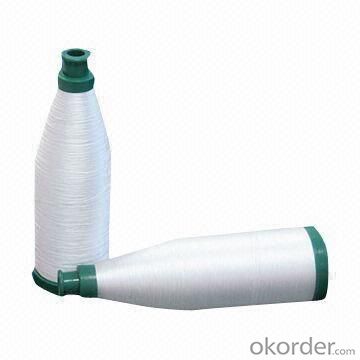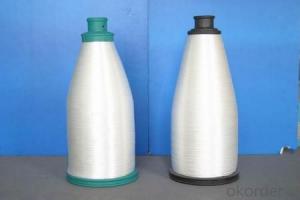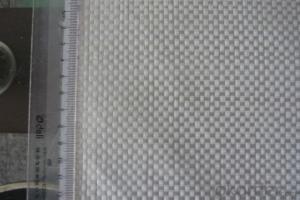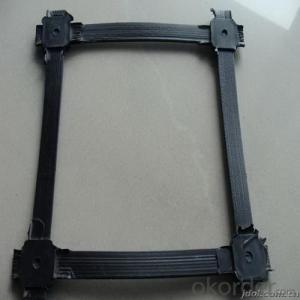Fiber Glass Textile Yarns
- Loading Port:
- China Main Port
- Payment Terms:
- TT or LC
- Min Order Qty:
- 20000 kg
- Supply Capability:
- 200000Kg Per Month kg/month
OKorder Service Pledge
OKorder Financial Service
You Might Also Like
1.Brief Introduction
C or E textile glass a kind of additional twisting and plying yam. With the characteristics of high strength, corrosion resistance, heat resistance and high moisture absorption, no-alkali yam has high electric insulation, so it used to produce weaved wires and cables’ wrap cladding, protection sleeve, train of mine, insulation materials of electric machinery, every yam of woven cloth and other industrial yam. It can also supply big and little paper cube and other cube yams with different shapes and different roll weight.
2.Product Features
Good Dispersibility.
Less fuzzy.
Density Even.
3.Product Specifications
Product Code | Tex | diameter (um) | Sizing. | breaking strength | Twist |
CC7.5-22-1/2 110S | 44 | 7.5 | paraffin | ≥15.5 | 110±10 |
EC9-33-1/2 65S | 66 | 9 | ≥24.1 | 65±5 | |
EC8-25-1/2 65S | 50 | 8 | ≥19.2 | 65±5 | |
CC9-33-1/2 65S | 33 | 9 | ≥20.6 | 65±5 | |
CC11-44-6/0 | 264 | 11 | ≥81.6 | ||
CC11-44-1/3 110S | 132 | 11 | silane | ≥40.8 | 28±3 |
EC9-68-1/0 28Z | 68 | 9 | ≥18.0 | 28±3 |
Special specification can be produce according to customer requirements.

4.FAQ
Storage:
Unless otherwise specified,It should be stored in a dry, cool and rain-proof area. It is recommended that the room temperature and humidity should be always maintained at 15℃~35℃ and 35%~65% respectively.
- Q:What industries commonly use fiberglass fabrics?
- Fiberglass fabrics possess exceptional properties and versatility, making them commonly utilized in various industries. Some industries that frequently employ fiberglass fabrics include: 1. Automotive Industry: The automotive sector heavily relies on fiberglass fabrics for the production of different components like car bodies, bumpers, hoods, and interior parts. The lightweight nature and high strength-to-weight ratio of fiberglass fabrics are ideal for enhancing fuel efficiency, overall performance, and durability. 2. Aerospace Industry: Fiberglass fabrics find numerous applications in the aerospace industry, particularly in the manufacturing of aircraft components. They are utilized in constructing wings, fuselages, rotor blades, and other structural elements. The strength, ability to withstand extreme temperatures, and low weight of fiberglass fabrics make them suitable for aerospace applications. 3. Construction Industry: The construction sector widely utilizes fiberglass fabrics for reinforcing concrete structures. Fiberglass-reinforced polymers (FRP) are commonly employed to enhance the strength, durability, and crack resistance of concrete elements like beams, columns, and slabs. Additionally, fiberglass fabrics are used in roofing materials, insulation, and as reinforcement in wallboards. 4. Marine Industry: The marine industry extensively relies on fiberglass fabrics due to their exceptional resistance to corrosion, water, and UV rays. They are employed in the production of boat hulls, decks, and other structural parts. The lightweight yet robust solutions provided by fiberglass fabrics make them highly suitable for various marine applications. 5. Sports and Recreation Industry: Many manufacturers of sports and recreational equipment utilize fiberglass fabrics in their products. Fiberglass fabrics are commonly found in sporting goods such as surfboards, kayaks, paddleboards, and skis. Their strength, flexibility, and impact resistance make them a popular choice in this industry. 6. Chemical and Industrial Applications: Fiberglass fabrics possess high resistance to chemicals, making them essential in industries dealing with corrosive substances. They are used in the production of chemical storage tanks, pipes, and ducts. Additionally, fiberglass fabrics are employed for insulation in thermal and electrical applications, including electronic equipment and furnaces. Overall, the remarkable properties of fiberglass fabrics enable them to have a wide range of applications across various industries. Their high strength, lightweight nature, resistance to corrosion, and versatility establish them as a preferred material for countless industrial and commercial uses.
- Q:How does fiberglass fabric perform in high-humidity environments?
- Fiberglass fabric performs exceptionally well in high-humidity environments. Due to its non-absorbent nature, it does not retain moisture and remains unaffected by the presence of water vapor in the air. This means that even in high-humidity conditions, fiberglass fabric maintains its structural integrity, strength, and dimensional stability. It does not warp, shrink, or become brittle like some other materials in humid conditions. Additionally, the non-porous nature of fiberglass fabric prevents the growth of mold, mildew, and other fungi that thrive in moist environments. This makes fiberglass fabric an excellent choice for applications such as boat building, outdoor furniture, and construction projects in high-humidity areas. Overall, fiberglass fabric's resistance to moisture and its ability to withstand high-humidity environments make it a reliable and durable material in such conditions.
- Q:Can fiberglass fabric be used for fire protection?
- Yes, fiberglass fabric can be used for fire protection. It has excellent fire-resistant properties and is often used in various industries, such as construction and manufacturing, to provide thermal insulation and prevent the spread of flames.
- Q:Can fiberglass fabric be used for making roller blinds?
- Yes, fiberglass fabric can be used for making roller blinds. Fiberglass fabric is a popular choice for roller blinds due to its durability and strength. It is resistant to moisture and UV rays, making it suitable for use in both indoor and outdoor settings. Additionally, fiberglass fabric is lightweight, allowing for easy operation and maintenance of roller blinds. The fabric is also available in a variety of colors and patterns, providing flexibility in design options. Overall, fiberglass fabric is a reliable and practical choice for making roller blinds.
- Q:Can fiberglass fabric be used for making conveyor belts?
- Yes, fiberglass fabric can be used for making conveyor belts. It is a durable and lightweight material that offers high tensile strength and excellent resistance to abrasion and chemicals, making it suitable for conveyor belt applications in various industries.
- Q:Are there any health risks associated with exposure to fiberglass fabrics?
- Exposure to fiberglass fabrics can indeed pose health risks. Fiberglass consists of minuscule, sharp fibers that easily become airborne when the fabric is disturbed or harmed. Inhaling or coming into contact with these fibers can cause irritation, itching, and redness on the skin. Furthermore, prolonged exposure to fiberglass fibers can result in more severe health problems like respiratory complications, lung damage, and even cancer. Besides direct contact, fiberglass fabrics can also emit tiny particles into the air, making them potentially hazardous to the respiratory system. Inhaling these particles can induce coughing, wheezing, and shortness of breath. Individuals with pre-existing respiratory conditions such as asthma or chronic obstructive pulmonary disease (COPD) may be particularly vulnerable to these effects. To mitigate the health risks associated with fiberglass fabrics, it is crucial to take precautions when handling or being around them. This entails wearing suitable personal protective equipment like gloves, goggles, and a respiratory mask to prevent direct contact and inhalation of the fibers. Additionally, it is important to handle fiberglass fabrics with care to prevent damage and the release of fibers into the air. If you suspect that you have been exposed to fiberglass fibers and are experiencing symptoms such as skin irritation or respiratory issues, it is advisable to seek medical attention. A healthcare professional can evaluate your condition and administer appropriate treatment if necessary.
- Q:How does fiberglass fabric perform in terms of breathability?
- Known for its exceptional breathability, fiberglass fabric is highly regarded due to its woven structure that enables air to circulate freely. This feature sets it apart from other materials as it allows moisture and condensation to escape, thus preventing the accumulation of mold and mildew. Moreover, the breathability of fiberglass fabric ensures comfort for individuals by dissipating heat and keeping the body cool and dry. Consequently, this key characteristic has resulted in the widespread utilization of fiberglass fabric across numerous industries and applications.
- Q:Can fiberglass fabric be used for reinforcement in water treatment tanks?
- Yes, fiberglass fabric can be used for reinforcement in water treatment tanks. Fiberglass is a strong and durable material that is resistant to corrosion and chemicals, making it suitable for use in water treatment applications. It can provide structural reinforcement to the tanks, ensuring their stability and longevity. Additionally, fiberglass fabric is lightweight and easy to install, making it a cost-effective solution for reinforcing water treatment tanks.
- Q:Can fiberglass fabric be used for making curtains or dividers?
- Fiberglass fabric is capable of being utilized in the creation of curtains or dividers. Its reputation lies in its durability, strength, and fire resistance, rendering it an appropriate material for these purposes. Additionally, it possesses a lightweight and flexible nature, facilitating effortless manipulation and installation. Furthermore, fiberglass fabric boasts easy cleaning and maintenance, making it a practical selection for curtains or dividers across diverse settings, including homes, offices, and industrial spaces.
- Q:Can I put up wall tiles on the bathroom wall waterproof cloth?
- Non-woven fabric, which is similar to a cloth that will base with cement mortar thin brush layer, it can be directly laid on the top.1, note: these three, no matter what kind of waterproof, around 300-500 higher than the ground to prevent water flowing along the wall to the following:1, brush the first waterproof coating. Before construction, make sure that the site is clean and dry, waterproof paint should be painted, no missing, and firmly integrated with the base, no cracks, no bubbles, no shedding phenomenon. Brushing height is consistent, the thickness should meet the product specification requirements.2, brush second times waterproof coating. Note that the first and second times waterproof paint between the need for a certain time interval, the first time after the dry coating can be carried out second times, the specific time depends on the paint. Interval time is too short, waterproof effect will be greatly reduced.3, laying protective layer. To prevent subsequent construction damage to the waterproof layer, it is necessary to put a protective coating on the surface of waterproof coating. The protection layer should be covered with waterproof layer without any omission. It is firmly integrated with the base layer, without cracks, no bubbles and no shedding.
1. Manufacturer Overview |
|
|---|---|
| Location | |
| Year Established | |
| Annual Output Value | |
| Main Markets | |
| Company Certifications | |
2. Manufacturer Certificates |
|
|---|---|
| a) Certification Name | |
| Range | |
| Reference | |
| Validity Period | |
3. Manufacturer Capability |
|
|---|---|
| a)Trade Capacity | |
| Nearest Port | |
| Export Percentage | |
| No.of Employees in Trade Department | |
| Language Spoken: | |
| b)Factory Information | |
| Factory Size: | |
| No. of Production Lines | |
| Contract Manufacturing | |
| Product Price Range | |
Send your message to us
Fiber Glass Textile Yarns
- Loading Port:
- China Main Port
- Payment Terms:
- TT or LC
- Min Order Qty:
- 20000 kg
- Supply Capability:
- 200000Kg Per Month kg/month
OKorder Service Pledge
OKorder Financial Service
Similar products
New products
Hot products
Hot Searches
Related keywords



























